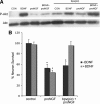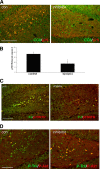ProNGF induces PTEN via p75NTR to suppress Trk-mediated survival signaling in brain neurons
- PMID: 21084616
- PMCID: PMC2996105
- DOI: 10.1523/JNEUROSCI.2581-10.2010
ProNGF induces PTEN via p75NTR to suppress Trk-mediated survival signaling in brain neurons
Abstract
Proneurotrophins and mature neurotrophins activate different signaling pathways with distinct effects on their target cells: proneurotrophins can induce apoptotic signaling via p75(NTR), whereas mature neurotrophins activate Trk receptors to influence survival and differentiation. Here, we demonstrate that the PTEN (phosphatase and tensin homolog deleted on chromosome 10) phosphatase represents a novel switch between the survival and apoptotic signaling pathways in rat CNS neurons. Simultaneous activation of p75(NTR) by proNGF and TrkB signaling by BDNF elicited apoptosis despite TrkB phosphorylation. Apoptosis induced by p75(NTR) required suppression of TrkB-induced phosphoinositide-3 kinase signaling, mediated by induction of PTEN, for apoptosis to proceed. Inhibition of PTEN restored the ability of BDNF to phosphorylate Akt and protect cultured basal forebrain neurons from proNGF-induced death. In vivo, inhibition or knockdown of PTEN after pilocarpine-induced seizures protected CNS neurons from p75(NTR)-mediated death, demonstrating that PTEN is a crucial factor mediating the balance between p75(NTR)-induced apoptotic signaling and Trk-mediated survival signaling in brain neurons.
Figures







Similar articles
-
Interaction of survival and death signaling in basal forebrain neurons: roles of neurotrophins and proneurotrophins.J Neurosci. 2006 Jul 19;26(29):7756-66. doi: 10.1523/JNEUROSCI.1560-06.2006. J Neurosci. 2006. PMID: 16855103 Free PMC article.
-
Induction of proneurotrophins and activation of p75NTR-mediated apoptosis via neurotrophin receptor-interacting factor in hippocampal neurons after seizures.J Neurosci. 2008 Sep 24;28(39):9870-9. doi: 10.1523/JNEUROSCI.2841-08.2008. J Neurosci. 2008. PMID: 18815271 Free PMC article.
-
ProBDNF induces neuronal apoptosis via activation of a receptor complex of p75NTR and sortilin.J Neurosci. 2005 Jun 1;25(22):5455-63. doi: 10.1523/JNEUROSCI.5123-04.2005. J Neurosci. 2005. PMID: 15930396 Free PMC article.
-
Neurotrophins in cultured cells from periodontal tissues.J Periodontol. 2003 Jan;74(1):76-84. doi: 10.1902/jop.2003.74.1.76. J Periodontol. 2003. PMID: 12593600 Review.
-
The protean actions of neurotrophins and their receptors on the life and death of neurons.Trends Neurosci. 2005 Jan;28(1):5-11. doi: 10.1016/j.tins.2004.11.003. Trends Neurosci. 2005. PMID: 15626491 Review.
Cited by
-
NMDA-dependent switch of proBDNF actions on developing GABAergic synapses.Cereb Cortex. 2013 May;23(5):1085-96. doi: 10.1093/cercor/bhs071. Epub 2012 Apr 17. Cereb Cortex. 2013. PMID: 22510533 Free PMC article.
-
NGF and proNGF regulate functionally distinct mRNAs in PC12 cells: an early gene expression profiling.PLoS One. 2011;6(6):e20839. doi: 10.1371/journal.pone.0020839. Epub 2011 Jun 3. PLoS One. 2011. PMID: 21677785 Free PMC article.
-
Pro-brain-derived neurotrophic factor inhibits GABAergic neurotransmission by activating endocytosis and repression of GABAA receptors.J Neurosci. 2014 Oct 1;34(40):13516-34. doi: 10.1523/JNEUROSCI.2069-14.2014. J Neurosci. 2014. PMID: 25274828 Free PMC article.
-
A CRMP4-dependent retrograde axon-to-soma death signal in amyotrophic lateral sclerosis.EMBO J. 2021 Sep 1;40(17):e107586. doi: 10.15252/embj.2020107586. Epub 2021 Jun 30. EMBO J. 2021. PMID: 34190355 Free PMC article.
-
Brain patterning perturbations following PTEN loss.Front Mol Neurosci. 2014 May 14;7:35. doi: 10.3389/fnmol.2014.00035. eCollection 2014. Front Mol Neurosci. 2014. PMID: 24860420 Free PMC article. Review.
References
-
- Alderson RF, Alterman AL, Barde Y-A, Lindsay RM. Brain-derived neurotrophic factor increases survival and differentiated functions of rat septal cholinergic neurons in culture. Neuron. 1990;5:297–306. - PubMed
-
- Backman SA, Stambolic V, Suzuki A, Haight J, Elia A, Pretorius J, Tsao MS, Shannon P, Bolon B, Ivy GO, Mak TW. Deletion of Pten in mouse brain causes seizures, ataxia and defects in soma size resembling Lhermitte-Duclos disease. Nat Genet. 2001;29:396–403. - PubMed
-
- Bibel M, Barde YA. Neurotrophins: key regulators of cell fate and cell shape in the vertebrate nervous system. Genes Dev. 2000;14:2919–2937. - PubMed
Publication types
MeSH terms
Substances
Grants and funding
LinkOut - more resources
Full Text Sources
Other Literature Sources
Research Materials
